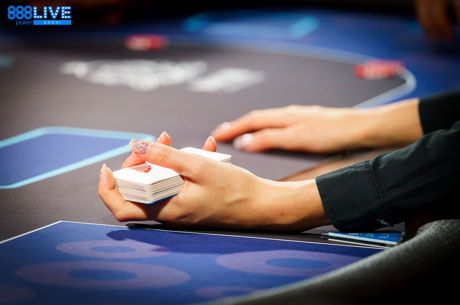Strategy Vault: Preflop Aggression in Live Cash Games with Bart Hanson

Digging deep into the PokerNews strategy archives can unearth some buried treasure for seekers of strategy gems. In this edition of the Strategy Vault, we look back to share some advice given to us by Bart Hanson, the long-time live cash-game grinder from Los Angeles who specializes in no-limit hold’em and limit Omaha hi-low eight-or-better.
Currently the owner and lead pro at Crush Live Poker, Hanson has a wealth of experience both as a coach and as a player. While he primarily focuses on cash games, he is an accomplished tournament player, too, picking up seven cashes at the 2015 World Series of Poker while helping the cause of Team Run It Up in in last summer's 25K Fantasy League.
In this strategy discussion, Hanson offered his thoughts about some of the key differences between online and live poker when it comes to preflop aggression.
How does three-bet bluffing differ in live poker compared to online?
It’s a little less profitable live than it is online because people aren’t opening as much. Their preflop raise frequency is lower, so their hand ranges are stronger. Players call three-bets out of position much more often. This isn't always necessarily bad because you can still get them to fold postflop, but in live games, they just fold much less often.
What situations do you look for in live games to three-bet bluff?
You can pick up information from players’ preflop raise-sizing. If you are observant about the way that people play, you might find that they raise smaller with high cards or suited connectors. If you’re playing $5/$10, they might only raise to $20 or $25, and if they have big pairs, they’ll raise to a lot more — to maybe $60 or $70. Also, raise sizes that are really big, like more than seven times the big blind as an open, are often medium-strength hands like sixes, sevens, or eights that are afraid to play postflop. So knowing your opponent’s preflop raise tendencies will give you a feel for when you can three-bet bluff.
I look for those situations when I think that someone is raising large with a medium-strength hand to three-bet bluff. Or let’s say a few players limp and the button makes it $35. He never has aces or kings. That’s prime for you to three-bet from the blinds. Most likely, his raise was to bloat the pot with suited cards or small pairs. And, as far as my range for three-betting goes, I’m mostly polarizing my three-betting range.
Why would you generally rather use a polarized three-bet range preflop?
Well, you should skew your three-bet range more toward value hands than bluffs, but I don’t three-bet hands like sevens and eights because I like to have a bigger stack-to-pot ratio. The thing about live play is that you don’t have to bloat the pot preflop. If you flop a big hand, you can almost always do it postflop even when you’re playing deep. If you flop a set against aces, you can just start building a pot right on the flop. It’s not a big deal to artificially inflate the pot.
Online, limping is most often a sign of a fish; however, it’s much more prevalent live. What’s your take on limping in live games?
I don’t do a whole lot of limping up front [from early position]. I still limp some pocket pairs up front, and in a passive game, I'll limp some suited connectors and suited aces. I used to open suited aces, but now, I think you want to limp with them because you want to have smaller suited cards call. That way, you have a chance to over-flush someone. Also, you can play a little more deceptively if you flop top pair or two pair.
You can also over-limp, which is a big part of live play and not part of online play. If there are a few limpers, and I’m in late position with a suited connector, I’ll limp. The only hands I’m raising to isolate are obviously value hands and high cards. Other than that, I don’t mind limping in with those hands... I’m not lot losing value by not raising preflop because when I hit my hand, I know how to properly extract value from my opponents postflop.
Let’s talk about four-bet ranges. Since players are three-bet bluffing so rarely in live poker, does that mean four-bet bluffs are almost nonexistent?
It’s so rare to see. I’ve thrown in a four-bet bluff a few times before because I know a player is three-betting with ace-jack or king-queen, because they've seen me open a lot. But it’s really rare. It’s not bad in live poker to basically have no four-bet bluffing range.
Does that mean you shouldn't four-bet for value with hands like aces and kings since you’re never four-bet bluffing?
That’s a valid point for the purposes of balance, but preflop, balance is a little overrated in live games. You don’t need to really concern yourself with balance to set up any type of meta game. Of course, this is [referring to] playing in one of the bigger houses like the Commerce Casino, which always has tons of games — [places where] you’re just playing with a lot of different players, and most of them don’t care or notice if you’re balancing your ranges or not. I think it just causes more problems to make moves just for balance in live games.
That said, when considering whether or not to four-bet for value, it depends on how deep you are. If you’re $3,000 deep in a $5/$10 game, I do want to four-bet with aces or kings because I want to try to stack my opponent. If I only flat the three-bet and then raise the flop, it puts me in a really weird spot if he calls, and it’s going to be almost impossible to get our stacks in.
I might also four-bet against someone who is willing to call the rest of his stack with ace-king, jacks or tens. A lot of times, if you just call preflop, the guy isn’t going to barrel off if he misses or if an overcard comes. I’d rather just get it in preflop.
Want to stay atop all the latest in the poker world? If so, make sure to get PokerNews updates on your social media outlets. Follow us on Twitter and find us on both Facebook and Google+!










